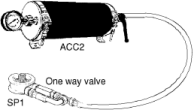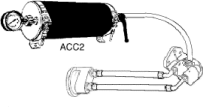 A)
To provide oil to the engine when the oil pump is unable to pick up oil from
the sump due to conditions of surge during acceleration, braking or cornering.
A)
To provide oil to the engine when the oil pump is unable to pick up oil from
the sump due to conditions of surge during acceleration, braking or cornering.B) To provide pre-lubrication to the engine when starting before the oil pump has built up pressure. Cold starts account for 80% of engine wear.
C) To iron out shock waves in the oil pressure system, caused by rapid rpm increase on a cold engine, sticky oil pressure relief valves, etc. Shock waves can damage oil filters, coolers, oil lines and oil pump drives.
D) To provide more engine power by lowering the level of oil in the sump thereby reducing crankshaft windage, the correct levels can only be achieved by experimentation and is best left to experts.
Construction. This device consists of a piston in a cylinder with air in the chamber behind the piston pre-pressurised to a minimum of 6psi. Engine oil pressure further compresses the air providing the means to store oil at normal engine operating pressure.
The main body is built from 4.1/4"(6 & 4 pint), 3.25"(2 pint) x 1/8" wall aluminium tubing, roller burnished and hard Teflon coated. End caps and pistons are aluminium and O-ringed . Has 0-160 psi gauge, a Schraeder valve for air pre-charge and either manual or electric control valves.
Choice of sizes. Because the maximum oil flow through an engine varies from 2 gallons (9 litres or 16 pints) per minute to 12 gallons (54.5 litres or 96 pints) per minute, then a 6 pint accumulator could give from 22 to 4 seconds protection, usually much longer at lower rpm. A 2 pint accumulator would be adequate at cranking speeds. Accumulator capacity could be increased by mounting an extra air reservoir in tandem.
 and a
one way valve to prevent oil returning through the pump. One way valves tend
to be either restrictive causing a small pressure drop or expensive (flap type).
NEW special sandwich plate with a built in valve does away with loop.
and a
one way valve to prevent oil returning through the pump. One way valves tend
to be either restrictive causing a small pressure drop or expensive (flap type).
NEW special sandwich plate with a built in valve does away with loop. protection from flow back through the pump if a filter with anti drain valve
is fitted.
protection from flow back through the pump if a filter with anti drain valve
is fitted.